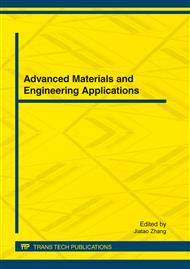[1]
Z. H. Zhang, X. Z. Yang, Z. L. Wang, et al, Study on experimental population of cochineal insect (D. Confusus (Cockerell)). Fore. Res. 16 (3) (2003) 254–261.
Google Scholar
[2]
Z. H. Zhang, L. Shi, L. F. Xu, et al, The present research and utilization situation of cochineal insects in the world. Fore. Res. 15 (6) (2002) 719–726.
Google Scholar
[3]
E. A. González, E. M. García, M. A. Nazareno. Free radical scavenging capacity and antioxidant activity of cochineal (Dactylopius coccus C.) extracts, Food Chem. 119 (1) (2010) 358–362.
DOI: 10.1016/j.foodchem.2009.06.030
Google Scholar
[4]
Y. H. Guo, L. Y. Ma, H. Zheng, et al, Free radical scavenging capacity of carminic acid. Food Sci. 31 (17) (2010) 73–76.
Google Scholar
[5]
J. Méndez, M. González, M. G. Lobo, et al, Color quality of pigments in cochineals (Dactylopius coccus Costa). J. Agr. Food Chem. 52 (5) (2004) 1331–1337.
DOI: 10.1021/jf0348929
Google Scholar
[6]
E. Takahashi, T. H. Marczylo, T. Watanabe, et al, Preventive effects of anthraquinone food pigments on the DNA damage induced by carcinogens in Drosophila. Mut. Res./ Fund. Mole. Mech. Mutag. 480-481 (2001) 139–145.
DOI: 10.1016/s0027-5107(01)00177-4
Google Scholar
[7]
H. K. L. Gupta, D. F. Boltz, Spectrophotometric study of the determination of boron by the carminic acid method. Microchimica Acta 62 (3) (1974) 415–428.
DOI: 10.1007/bf01219720
Google Scholar
[8]
L. López-Martínez, J. L. Guzmán-Mar, P. L. López-de-Alba, Simultaneous determination of uranium(Ⅵ) and thorium(Ⅳ) ions with carminic acid by bivariate calibration. J. Radioanal. Nuc. Chem. 247 (2) (2001) 413–417.
DOI: 10.1023/a:1006786525345
Google Scholar
[9]
J. L. Manzoori, M. H. Soroiraddin, M. Amjadi, Spectrophotometric determination of osmium based on its catalytic effect on the oxidation of carminic acid by hydrogen peroxide. Talanta 53 (1) (2000) 61–68.
DOI: 10.1016/s0039-9140(00)00383-0
Google Scholar
[10]
S. Gaweda, G. Stochel, K. Szaciliwski, Photosensitization and photocurrent switching in car- minic acid/ titanium dioxide hybrid material. J. Phys. Chem. C 112 (48) (2008) 19131–19141.
DOI: 10.1021/jp804700d
Google Scholar
[11]
H. Zhang, Y. M. Lu, H. Zheng, et al, Optimization of water extraction of cochineal dye. Food Sci. 30 (16) (2009) 115–118.
Google Scholar
[12]
Y. Cui, W. H. Li, X. Tang, et al, Study on extracting pigment from cochineal insect. Chem. Engin. 35 (6) (2007) 66–69.
Google Scholar
[13]
M. Gonzaälez, J. Meändez, A. Carnero, Optimizing conditions for the extraction of pigments in cochineals (Dactylopius coccus Costa) using response surface methodology. J. Agr. Food Chem. 50 (24) (2002) 6968–6974.
DOI: 10.1021/jf025756r
Google Scholar
[14]
Y. M. Lu, H. Zheng, H. Zhang, et al, Ultrasonic extraction of cochineal dye. Food Sci. 30 (16) (2009) 142–145.
Google Scholar
[15]
Y. M. Lu, H. Zheng, M. C. Zhou, et al, Study on extraction of cochineal dye by microwave technique. Hubei Agr. Sci. 48 (3) (2009) 707–709.
Google Scholar
[16]
Y. H. Guo, L. Y. Ma, H. Zheng, et al, Comparison of HPLC and spectrophotometric methods for quantitative analysis of carminic acid. Food Sci. 30 (18) (2009) 303–306.
Google Scholar
[17]
G. M. Zhao, G. H. Zhou, X. L. Xu, et al, Changes of dipeptidyl peptidase Ⅳ in the processing of Jinhua Ham. Scientia Agricultura Sinica 38 (1) (2005) 151–156.
Google Scholar
[18]
J. Jia, L. Yang, Y. G. Zu, Homogenated extraction of oligomeric proanthocyanidins from larch bark and its optimization by response surface methodology. Chem. Indus. Fore. Prod. 29 (2009) 78–84.
Google Scholar
[19]
X. J. Shang, J. Q. Qian, H. Guo, Optimazation of extraction of alkaloids from Corydalis yanhu- suo W. T. Wang by response surface methodology. Chem. Indus. Fore. Prod. 30 (2010) 32–36.
Google Scholar
[20]
L. Yang, Z. Y. Wang, Optimization of the processing parameters for extraction of antioxidants from blackberry using response surface methodology. Chem. Indus. Fore. Prod. 30 (2010) 67–72.
Google Scholar


